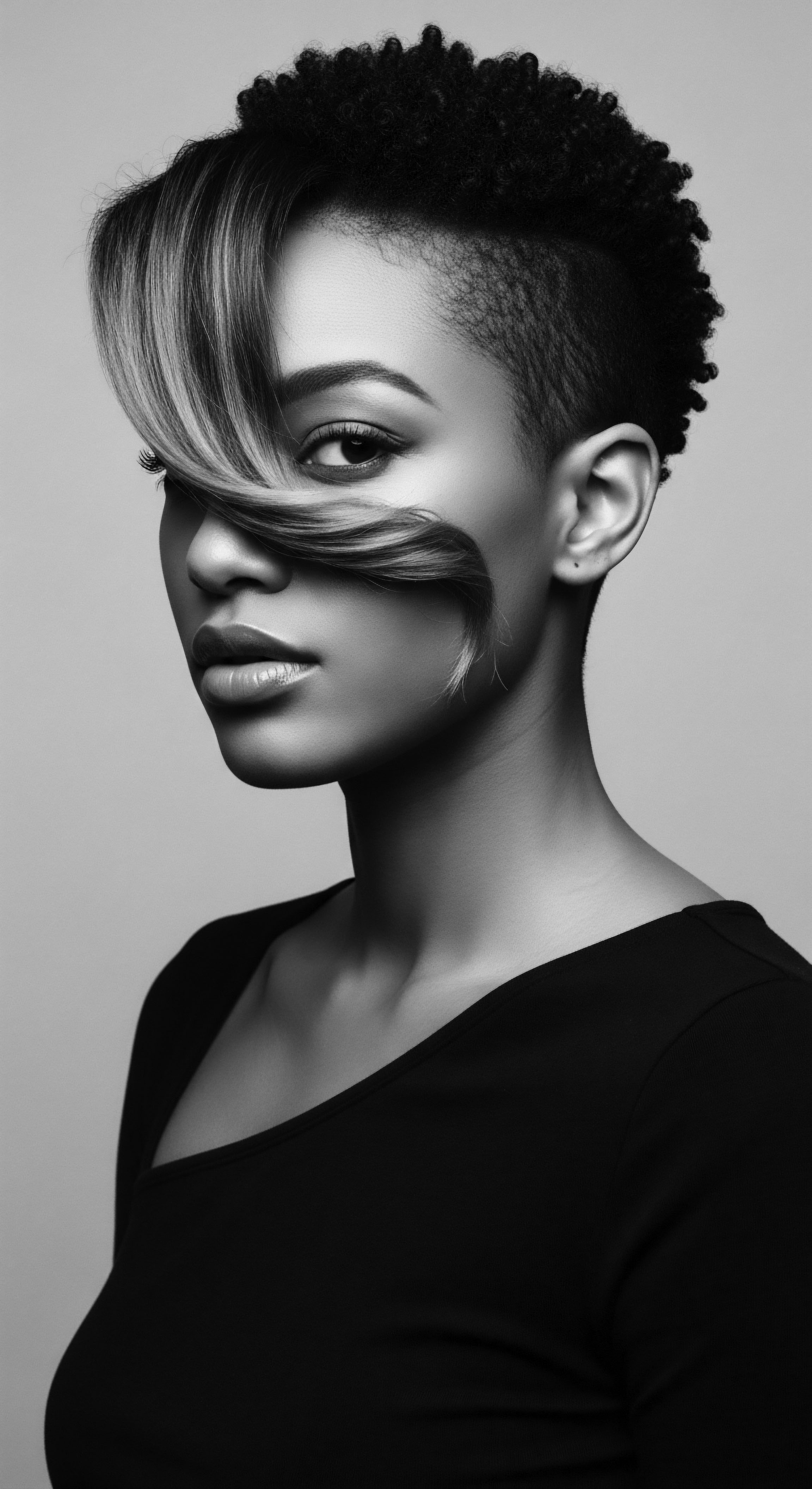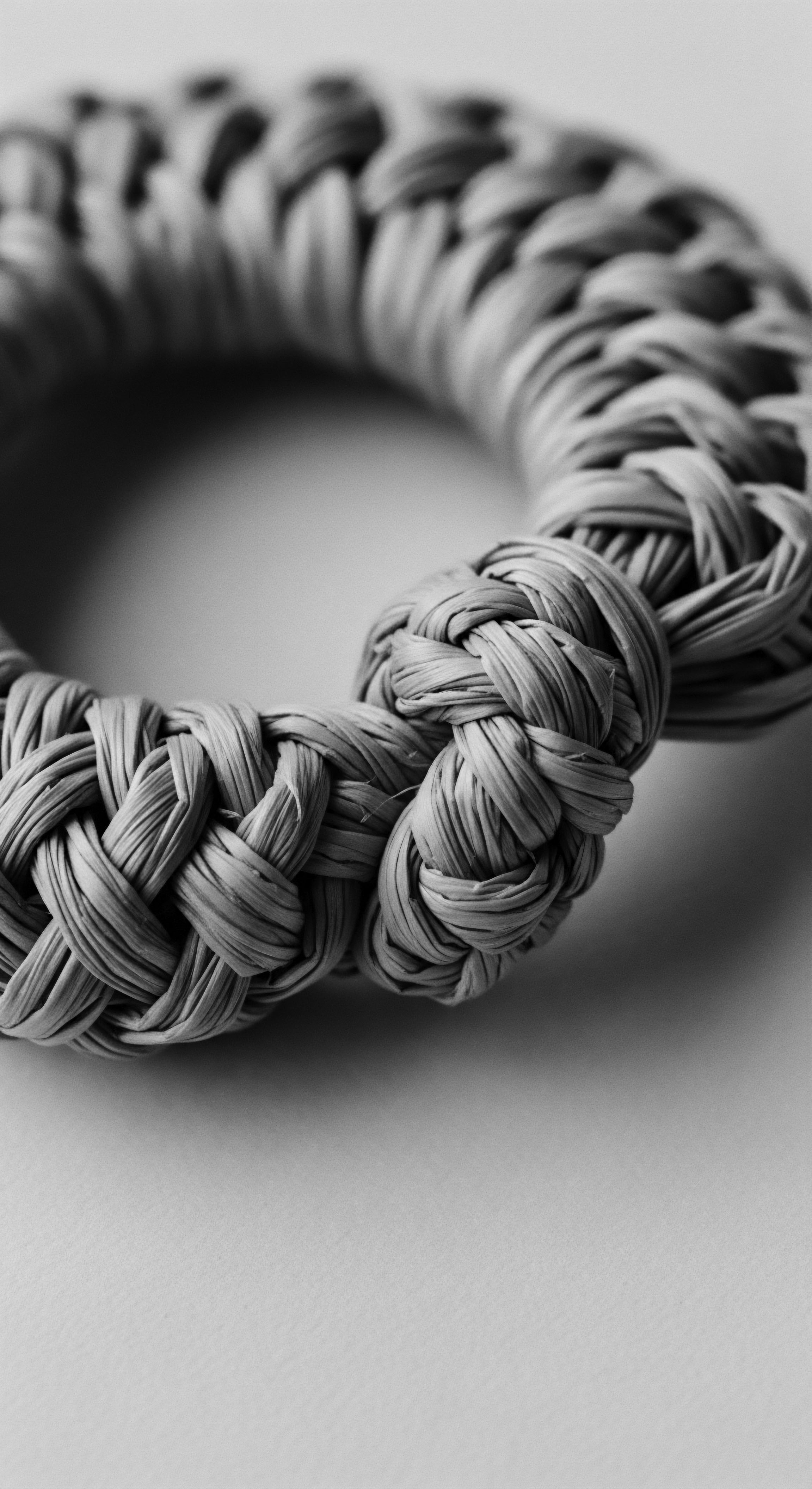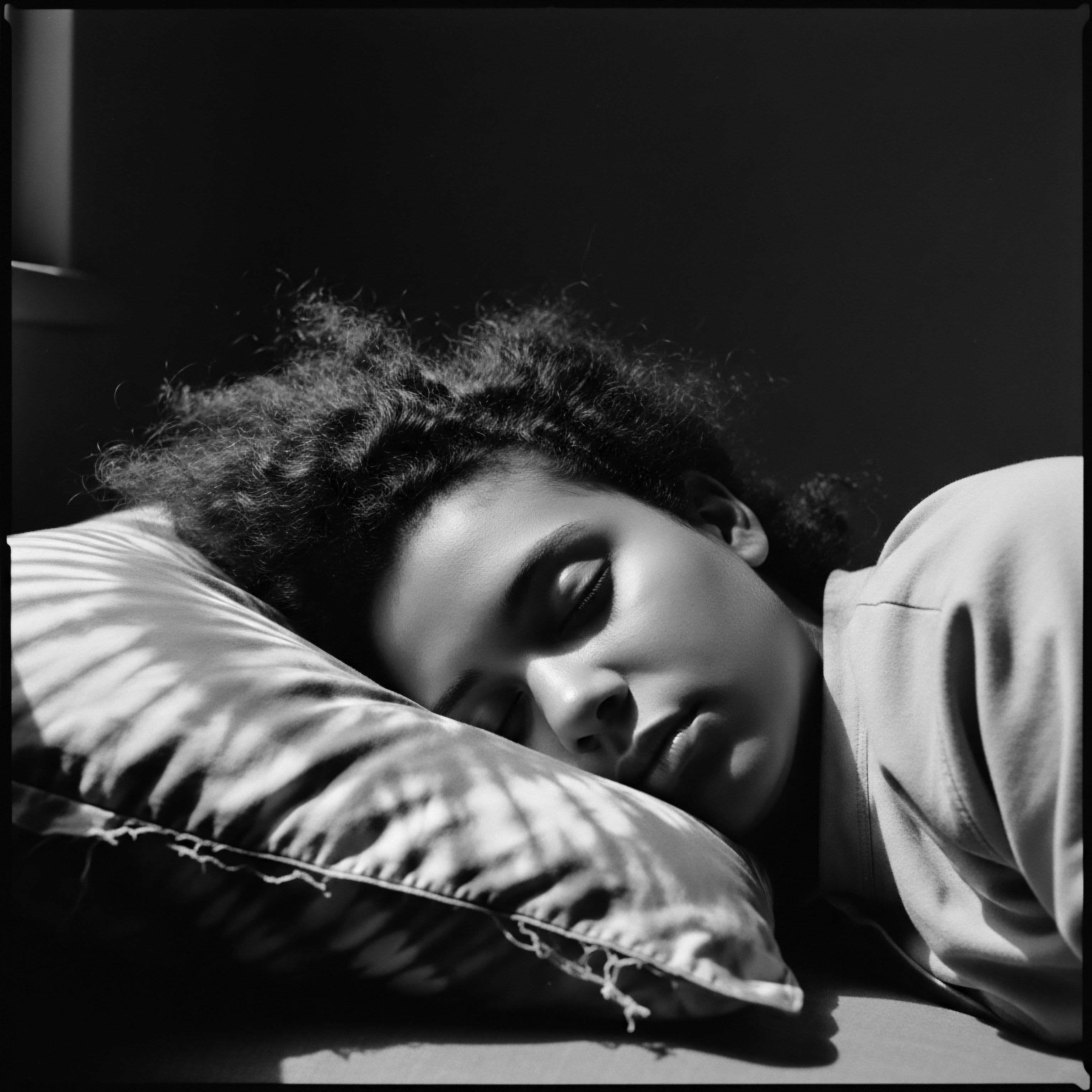
Roots
In the quiet spaces where memory settles, where the wisdom of generations breathes, we find the answers to our hair’s ancient questions. The very strands that crown our heads carry stories, echoes of sun-drenched lands and ancestral rituals. For those with textured hair, a lineage often misunderstood in modern contexts, the connection to earthen elements holds particular significance. We ask, does ghassoul, a treasure born of the Atlas Mountains, truly honor and nourish specific textured hair types, speaking to a heritage that spans continents and centuries?
The genesis of any profound understanding resides in its foundations. Textured hair, in its myriad coils, curls, and kinks, possesses an intrinsic architecture that demands reverence and precise care. Before we speak of ghassoul, we must first honor the hair itself, recognizing its distinct anatomy and the language that defines it, shaped by ancestral and contemporary understanding.

Hair Anatomy and Its Ancestral Forms
A single strand of hair, seemingly simple, holds within it a complex universe. Its outermost layer, the cuticle, resembles overlapping scales, like tiny shingles on a roof. Beneath this, the cortex provides strength, and at its core, the medulla, sometimes absent in finer strands, influences resilience. For textured hair, the follicular journey beneath the scalp is often oval or elliptical, dictating the characteristic curl pattern that emerges.
This shape causes the hair shaft to twist and turn, creating natural points of vulnerability where moisture can escape more easily, and external elements can intrude. This biological truth underscores why ancestral care practices were so profoundly focused on protection and moisture retention.
Across diverse African communities, understanding the hair’s inherent qualities wasn’t a scientific endeavor in the modern sense, but an intuitive knowledge passed down, generation to generation. Elders observed how certain plants or clays interacted with the hair, noting their effects on softness, cleanliness, or strength. This deep, experiential learning formed the bedrock of care. The hair’s structure, whether tight coil or flowing wave, guided the choice of cleansing agent, the specific application, and the very rhythm of ritual.
The intrinsic architecture of textured hair, with its unique follicular journey, shaped ancestral practices of care and protection.

Describing Textured Hair’s Forms
The contemporary systems for classifying textured hair often employ numerical and alphabetical scales, offering a detailed framework for distinguishing curl patterns. These systems, while useful for product formulation and communication in the modern beauty sphere, sometimes overshadow the more holistic, descriptive terminologies found within traditional African communities.
- Coil Patterns ❉ These include the tightest curl formations, often appearing as small, spring-like spirals or zig-zag patterns. This hair type historically benefited from minimal manipulation and gentle, hydrating cleansing.
- Curl Formations ❉ Ranging from loose waves to defined spirals, these patterns vary in circumference. Their care often involved methods that preserved their natural spring and minimized frizz.
- Kinky Hair ❉ Characterized by sharp, angular bends, this hair type is particularly prone to dryness and breakage. Traditional practices emphasized emollients and protective styles.
Long before universal systems, the language used by African peoples to speak of hair was intimately tied to its feel, its behavior, its visual splendor, and its cultural significance. A specific texture might be likened to a plant, a natural phenomenon, or a communal symbol, imbuing it with layers of meaning beyond mere appearance.
| Aspect of Classification Primary Focus |
| Ancestral Perspective Hair's behavior, cultural meaning, and intuitive response to elements |
| Modern Scientific View Defined curl pattern, porosity, density, and strand width |
| Aspect of Classification Terminology |
| Ancestral Perspective Descriptive, often poetic, linked to nature or communal life |
| Modern Scientific View Numerical and alphabetical systems (e.g. 3C, 4A) |
| Aspect of Classification Care Guidance |
| Ancestral Perspective Passed down through observation and oral tradition, deeply personalized |
| Modern Scientific View Informed by research into hair's molecular structure and ingredient interaction |
| Aspect of Classification The deep respect for hair's individuality is a thread connecting ancient wisdom to contemporary understanding. |

Hair Growth Cycles and Ancient Nourishment
Hair grows in cycles ❉ anagen (growth), catagen (transition), and telogen (rest and shedding). While this biological rhythm is universal, the health of each cycle is profoundly impacted by environmental factors, nutrition, and, critically, care practices. In communities across the African continent, dietary staples rich in vitamins and minerals naturally supported robust hair growth.
Foods like leafy greens, tubers, and lean proteins, cultivated in fertile lands, provided the internal nourishment for healthy hair. This understanding, though not articulated in biochemical terms, was manifested in traditions that prioritized vibrant, well-tended bodies.
The practice of regularly applying natural oils, butters, and indeed, clays, was not merely for appearance. It addressed concerns such as breakage and dryness. For instance, the Bassara/Baggara Arab tribe in Chad traditionally used Chébé powder, derived from the seeds of the Chébé plant, mixed with moisturizers to aid length retention and protect hair (Adekola, 2024).
This type of ancestral practice highlights a deep awareness of hair health and its cycles, even without the precise scientific terminology we use today. It suggests that specific care, adapted to particular hair needs, has a long lineage.

Ritual
To speak of ghassoul and textured hair is to speak of ritual—a deliberate sequence of actions imbued with purpose and often, with sacred meaning. Long before the advent of commercial shampoos, communities across North Africa, particularly the Berber peoples, turned to the earth’s bounty for cleansing and adornment. Ghassoul, also known as rhassoul, a volcanic clay sourced from the depths of the Atlas Mountains, represents a testament to this ancestral wisdom. Its name, derived from the Arabic word meaning ‘to wash,’ speaks volumes about its historical function.

Ghassoul’s Ancestral Presence in Cleansing Rituals
The use of ghassoul for hair and body care stretches back thousands of years, with mentions even appearing in ancient Egyptian papyri. This lineage positions ghassoul not as a trend, but as a time-honored element within the extensive tapestry of Black and mixed-race hair care heritage. Its primary use was as a gentle cleanser, a mud wash that purified the scalp and strands without stripping away vital moisture—a concern that remains central for textured hair today. In the traditional Moroccan hammam, a communal bathhouse ritual, ghassoul served as a centerpiece for spiritual and physical purification.
The application of ghassoul in these settings was a sensory experience, a meditative act. Women would mix the dry clay with warm water, sometimes adding rosewater or argan oil, to create a smooth, rich paste. This mixture would then be massaged into the hair and scalp, allowing its mineral properties to absorb impurities.
This gentle approach contrasts sharply with the harsh, stripping cleansers that later emerged in Western beauty markets, which often caused damage to delicate textured strands. The preservation of the hair’s natural oils was paramount in these traditional methods.
Ghassoul clay’s long history in North African hammam rituals exemplifies an ancestral understanding of gentle cleansing for textured hair.

Why Ghassoul Supports Textured Hair
Ghassoul clay possesses a unique mineral composition, including high levels of silica, magnesium, potassium, and calcium. These elements contribute to its cleansing properties. When mixed with water, ghassoul develops a negative ionic charge. This charge acts like a magnet, drawing out positively charged impurities, toxins, and excess sebum from the hair and scalp, effectively cleansing without harsh detergents.
This gentle, non-stripping action is precisely what textured hair, often prone to dryness due to its coiled structure, requires. The clay also has a mild abrasive texture, aiding in the removal of dead skin cells from the scalp, which promotes a healthy environment for growth.
For textured hair, maintaining moisture is a constant quest. Unlike many conventional shampoos that can leave the hair feeling brittle and parched, ghassoul cleanses while helping to preserve the hair’s natural hydrolipidic film. This film is crucial for moisture retention, providing a protective barrier. The clay’s ability to soften and condition the hair also helps with detangling, reducing mechanical stress and potential breakage, which are common challenges for intricate curl patterns.

Does Ghassoul Effectively Cleanse Various Textured Curl Patterns?
Yes, ghassoul offers a cleansing mechanism that respects the integrity of various textured curl patterns. Its anionic properties enable it to bind to impurities without disrupting the hair’s natural lipid balance, making it suitable for a spectrum of textures, from looser waves to the tightest coils. Its gentleness is a particular advantage for hair types that are naturally drier and more susceptible to stripping by conventional cleansers. The mud-like consistency ensures a thorough, yet non-lathering, wash that can be worked through dense strands without causing excessive tangling.

Traditional Uses in Hair Definition
Beyond cleansing, ghassoul found a place in ancestral styling and hair definition. The softened, moisturized state of the hair post-ghassoul application made it more pliable, easier to manage, and better prepared for traditional protective styles. While not a styling agent itself in the modern sense, its conditioning properties helped prepare the hair.
This foundational care contributed to the longevity and beauty of styles that held deep cultural significance, such as braids, twists, and various forms of threading. These styles, often adorned with cowrie shells, beads, or other elements, were not only aesthetic expressions but also conveyed social status, age, marital status, and tribal affiliation.
The synergy between ghassoul and other traditional ingredients, such as argan oil or rose water, created comprehensive hair rituals that addressed both health and appearance. The use of ghassoul exemplifies a practical application of ancestral knowledge that supported the inherent qualities of textured hair, ensuring its health and enabling its stylistic expressions.

Relay
The enduring narrative of ghassoul clay is a testament to the wisdom passed through generations, a cultural relay that connects ancient knowledge to contemporary understanding. Its efficacy for textured hair is not merely anecdotal; it is increasingly affirmed by scientific insights that explain the very mechanisms observed by our ancestors. This convergence of traditional practice and modern science enriches our appreciation for how these natural elements contribute to hair wellness, particularly for those with a legacy of highly structured strands.

The Science Supporting Ghassoul’s Action
From a scientific standpoint, ghassoul is a stevensite clay, a type of smectite clay mineral. Its unique layered structure and high cation exchange capacity are key to its beneficial actions. The clay’s mineral composition, abundant in magnesium silicate, allows it to absorb excess sebum and impurities through a process of adsorption, where substances adhere to the surface of the clay particles. Unlike many synthetic detergents that strip the hair by breaking down its lipid barrier, ghassoul acts more like a blotting paper, drawing away what is unnecessary without disrupting the hair shaft or scalp’s natural protective oils.
This gentle yet effective cleansing action is particularly advantageous for various types of textured hair. For tightly coiled or kinky hair, which naturally produces less sebum along the length of the strand due to its numerous bends, harsh detergents can exacerbate dryness and breakage. Ghassoul provides a cleansing solution that respects this inherent dryness, allowing the hair’s natural moisture to remain.
For looser curls or wavy textures that might experience more oil buildup at the scalp but still need moisture retention in the mid-lengths and ends, ghassoul can effectively purify the scalp while conditioning the hair, promoting balance. Its ability to maintain the scalp’s pH balance also supports a healthy microbiome, discouraging fungal overgrowth or irritation.

Which Specific Characteristics of Textured Hair Benefit Most from Ghassoul?
Ghassoul tends to show its most pronounced benefits on textured hair types that contend with a delicate balance of cleansing and moisture retention, particularly those prone to dryness and sensitivity. This includes hair with Medium to High Porosity, which absorbs and loses moisture quickly, as ghassoul offers a gentle cleanse that does not further deplete hydration. Hair types with Dense, Tightly Coiled Patterns (often classified as 4C, 4B, and some 4A types) experience considerable advantage because its non-stripping nature helps preserve their natural oils and minimizes shrinkage.
Additionally, individuals with Sensitive Scalps or those prone to buildup and mild irritation find relief, as the clay cleanses without harsh chemicals. It also helps those with hair that frequently experiences tangling, as its conditioning properties make the strands more manageable for detangling post-wash.
The traditional understanding, passed down through the generations, was not codified in scientific terms but reflected these observed benefits. For example, Berber women in Morocco consistently used ghassoul for hair cleansing, a practice deeply rooted in their communal hammam rituals. This tradition, passed from mother to daughter, served as a practical solution for maintaining scalp health and hair integrity in an environment where moisture retention was paramount.
The fact that ghassoul was often part of a bridal dowry in Moroccan culture speaks to its perceived value in ensuring a woman’s beauty and well-being for her new life (Mounir, 2017). This historical data underscores its deep cultural embedding and functional efficacy for textured hair within a specific heritage context.

Ghassoul Across the Textured Hair Spectrum
While often associated with tightly coiled patterns, ghassoul’s adaptability extends across a broad spectrum of textured hair. The key lies in preparation and application. For very fine or low-density textured hair, a thinner consistency of the ghassoul mixture or less frequent use may be ideal to avoid weighing down the strands.
For thicker, denser textures, a richer paste and more thorough application ensures every strand benefits. The practice of infusing the clay with botanicals—a custom deeply seated in ancestral practices—further personalizes its use.
Consider the varying ways ghassoul could be employed:
- For Scalp Detoxification ❉ Its absorbent qualities make it ideal for drawing out impurities and product buildup from the scalp, particularly for individuals who use heavy creams or butters. This is significant for hair types prone to scalp congestion due to their dense growth patterns.
- As a Pre-Poo Treatment ❉ Applied before a traditional wash, ghassoul can help to loosen dirt and tangles, preparing textured hair for a gentler cleansing experience. This method aids in retaining moisture during the subsequent wash.
- For Softness and Manageability ❉ The minerals in ghassoul contribute to improved hair texture, making strands feel softer and more pliable. This directly aids in the detangling process, a significant challenge for many textured hair types.
The relay of this knowledge from ancient hamlets to modern self-care routines is a powerful illustration of heritage. It shows how ancestral wisdom, once considered purely traditional, now finds validation within the language of science. This dual understanding allows us to appreciate ghassoul not just as a product, but as a living connection to a profound history of hair care, a practice that has sustained and celebrated textured hair for millennia.
The historical use of ghassoul, especially within Moroccan bridal traditions, reveals its cultural value as a staple for textured hair wellness.

Reflection
The journey through ghassoul’s connection to textured hair is more than a study of properties and applications; it is a profound meditation on the enduring soul of a strand. Each coil and curve carries within it the echoes of countless generations who understood the intimate dialogue between their bodies and the earth. The very act of engaging with ghassoul, this ancient clay, becomes a tender act of remembrance, a re-connecting with ancestral rhythms that prioritized holistic well-being over fleeting trends.
The enduring legacy of ghassoul in the care of textured hair serves as a luminous reminder that solutions to our modern hair queries often lie buried within the wisdom of our forebears. It beckons us to look beyond the superficial, to perceive hair as a living, breathing archive of identity, resilience, and beauty. This is a story not just of clay and hair, but of cultural continuity, of inherited strength, and of the sacred act of self-care as a profound homage to our collective heritage.

References
- Adekola, S. (2024). Ancient Gems ❉ A Historical Survey of African Beauty Techniques. Obscure Histories .
- BIOVIE. (2025). What are the benefits of rhassoul clay? BIOVIE.
- Ecosystem Laboratoire. (2024). Ghassoul ❉ history, benefits and uses. Ecosystem Laboratoire.
- Matike, D. Ekosse, G. & Ngole, V. (2010). Indigenous knowledge applied to the use of clays for cosmetic purposes in Africa ❉ an overview. Indilinga African Journal of Indigenous Knowledge Systems, 9(2), 138-150.
- MINATURE. (2024). Benefits and Uses Of Moroccan Rhassoul Clay for Hair & Skin. MINATURE.
- Moroccan Sense. (n.d.). Clay rhassoul – Moroccan Sense. Moroccan Sense.
- Mounir, H. (2017). The Amazing Benefits of Ghassoul Clay. Ghassoul.com .
- Rolling Out. (2025). The ancient haircare secret that’s backed by modern science. Rolling Out .
- Substack. (2025). Ancestral Hair Rituals to Nourish Your Hair and Soul. Substack .
- Vertex AI Search. (2024). Rhassoul ❉ a ritual for hair and skin care to purify and relax body and soul. Vertex AI Search.
- Vertex AI Search. (2025). Rhassoul Clay ❉ A Treasure for Afro and Textured Hair. Vertex AI Search.
